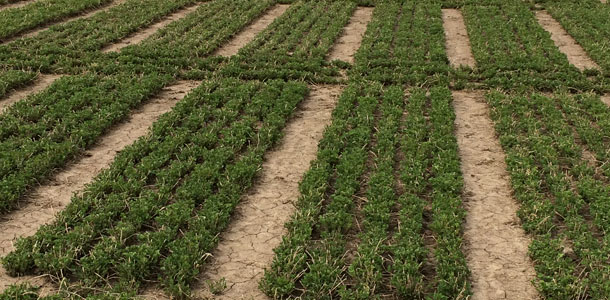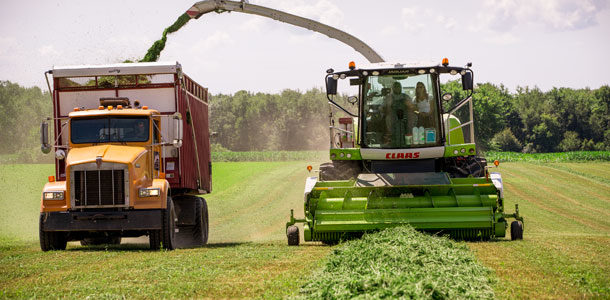To harvest, they used mechanical mowers or flair choppers to cut alfalfa forage and then weighed it using field scales.
This required many people to collect the forage and bring it to a hanging scale for weighing. Over time, mechanical harvesters were developed with onboard electronic weighing systems to streamline the process and reduce labor requirements of alfalfa plot harvest.
On the farm, alfalfa yield was historically measured by counting hay bales or the number of wagons of haylage harvested from a field. This, of course, was an inexact method due to unknown weights and variable moisture content. More recently, forage growers have access to drive-over scales or wagons with weighing systems to measure the weight of forage from a strip or field.
Modern forage choppers are now equipped with yield monitors similar to those found in grain combines. This allows for a new level of forage measurement based on geographical location within a field. Forage chopper yield monitors open the door to understanding alfalfa yield potential across soil types or management strategies within the same field.
Challenges of yield comparison with alfalfa
Alfalfa is a perennial crop with multiple harvests each year. Analyzing the genetic yield potential of an alfalfa variety can be approached from at least two different perspectives. Growers could make decisions based on how well a variety performs when plant health, stand uniformity and growing conditions are ideal.
However, more growers want to know how a variety stands up to the real-world conditions experienced in an alfalfa field over time. They want to know if it is winter-hardy and disease-resistant in addition to having high yield potential.
Measuring the yield potential of an alfalfa variety is complicated by the range of conditions under which the crop is grown. Yield is influenced by multiple factors, including summer growing temperatures and rainfall patterns, harvest frequency and fall harvest management – along with winter conditions. Also, soil fertility and pH changes over time, disease pressure and insect pressure will all influence yield potential.
Additional factors making alfalfa yield measurement and comparisons more difficult are the relatively low yields per cutting and the small range of differences among varieties or management techniques. High replication in small plots is required to demonstrate true statistical differences, increasing the overall expense and time required.
When comparing varieties or crop-management treatments on the farm, another level of variability is introduced in the size of harvest equipment and soil variability. Careful measurement of the harvested area is required to determine yield from a side-by-side strip comparison across a field. Also, it is unlikely that multiple replications will be harvested due to the space and harvest time limitations.

What is the best alfalfa comparison strategy today?
Because of all the complicating factors for measuring alfalfa yield, comparing and selecting alfalfa varieties is challenging. No single location or single harvest will tell you which variety will consistently give you the best performance on your farm. Here are a few strategies for selecting varieties:
- Find a reputable seed company with reliable data across multiple years, cuttings and locations.
- Use university trial data from multiple years and locations.
- The variety with the highest absolute yield number isn’t necessarily the winner for your farm – pick varieties in the top 10 to 20 percent, as these will all likely be consistent performers.
- Don't forget selection for key disease traits to help protect yield – most trials will not show a variety's response to disease pressure or winter hardiness.
The coefficient of variation (CV), frequently reported in university variety trial data, is probably the simplest and single most useful statistic you can use to decide whether a test is reliable for comparisons among varieties.
An ideal forage yield trial will have a trial CV of 8 to 10 percent or less. Tests with CVs greater than 12 percent do not discriminate well enough to separate varieties. Forage yield differences must be very large to conclude that one variety is significantly better (or worse) than another when CVs are greater than 15 percent.
When making on-farm comparisons, use the following steps to help make more reliable measurements of yield and comparisons of treatment differences.
- With side-by-side strip comparisons, use a buffer area between treatments and harvest the full length of a field when possible.
- Sample for moisture to adjust for differences in dry matter.
- Replicate whenever possible.

The future of alfalfa yield monitoring
Future measurement of forage yield and comparison of alfalfa varieties will involve the use of a forage chopper equipped with forage yield monitoring equipment and GPS mapping capabilities. These technologies will bring a new opportunity to understand variety performance and crop-management treatments on your farm.
While some of the same challenges exist for measuring yield, this new technology will allow you to measure and map alfalfa yields over time and space. Then, using integrative software, a better picture of alfalfa performance on your fields will be available.
One of the biggest benefits may be watching the performance of your fields over time. As you see yields drop off in a field, it will help you understand when to rotate out of a stand early versus later. Also, seeing the impact of fertility or pesticide treatments across entire field strips or various soil types will help you make better forage management decisions for your operation.
Connect with your local forage equipment dealer to get engaged in the new science of forage yield monitoring. While there is a learning curve, the opportunities to measure forage yield by the square foot are too great to miss out on. Using these newest technologies will help keep alfalfa positioned as a key forage on your dairy farm. FG

Dan Wiersma
Livestock Information Manager
DuPont Pioneer
PHOTOS
TOP: Measurement during alfalfa harvest can be challenging, but knowledge is power when selecting forages.
MIDDLE: Drive-over scales can help growers evaluate success of alfalfa plantings.
BOTTOM: Strip comparisons are an important way to evaluate alfalfa varieties for your operation. Photos provided by DuPont Pioneer.










